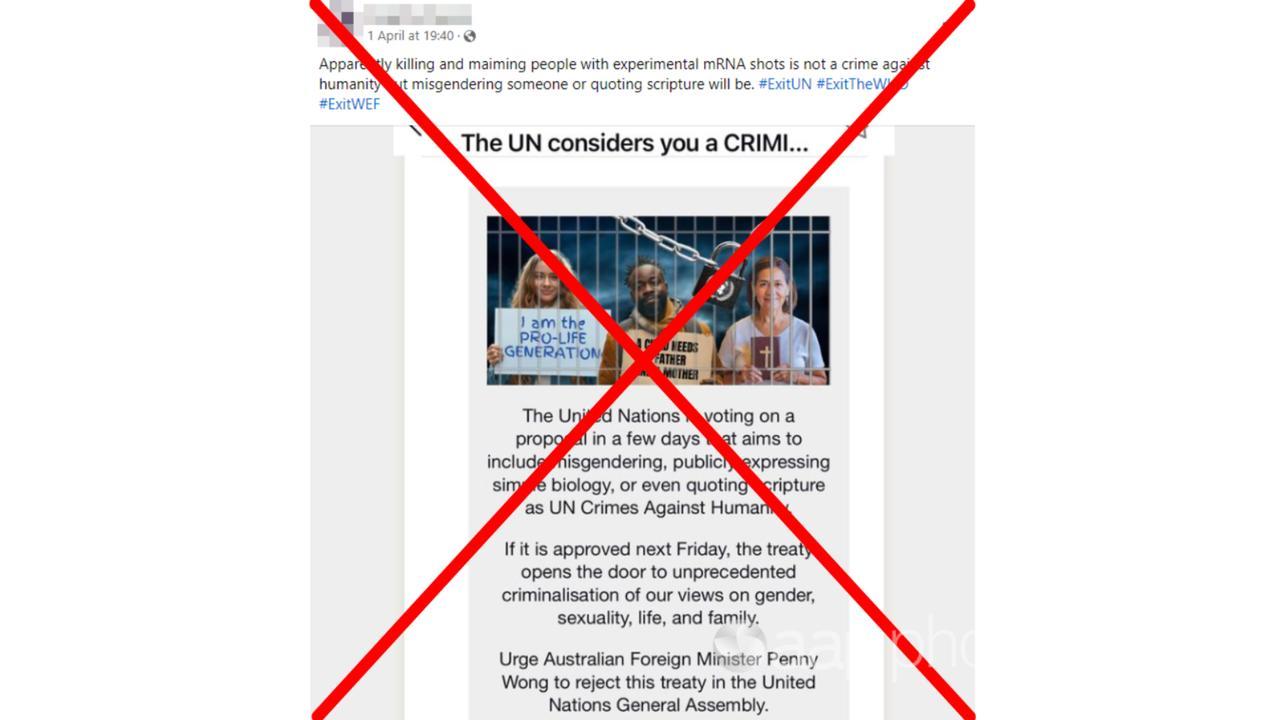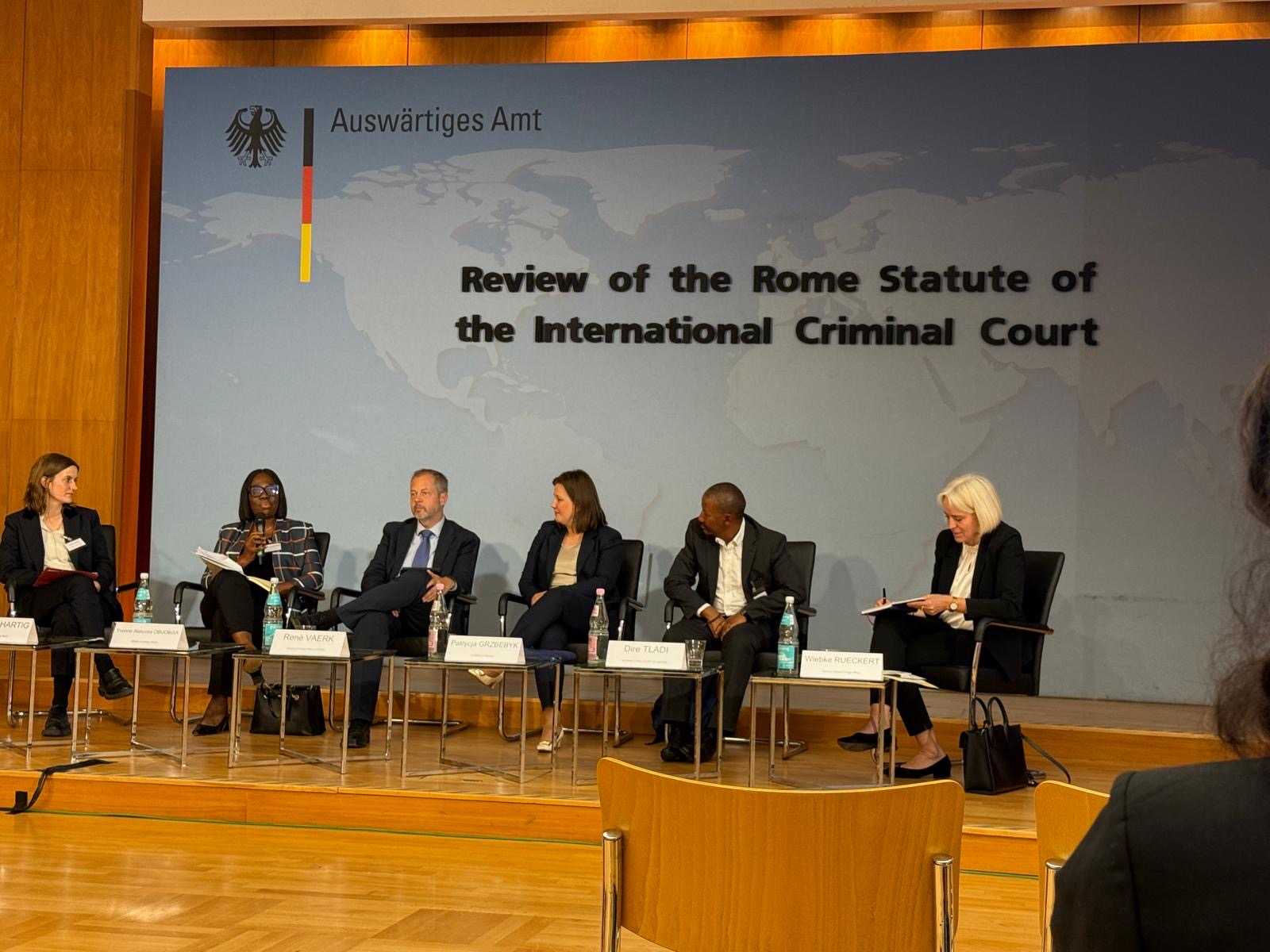
The United Nations and Crimes Against Humanity
The United Nations may soon classify misgendering or even quoting scripture as a crime against humanity, according to posts on social media.
False Claim
This claim is false. In April 2024, the UN held wide-ranging meetings about crimes against humanity. These discussions included a proposal to change how gender is interpreted in modern society.
Legal experts have dismissed the claim as “hyperbolic nonsense.”
The Facebook Post
The claim was made in a Facebook post on April 1. The post states, “Apparently killing and maiming people with experimental mRNA shots is not a crime against humanity but misgendering someone or quoting scripture will be,” referencing anti-vaccine sentiment.

The same text is used in an X post and is taken from a blog about a petition from the CitizenGo group.
The blog states: “The UN is contemplating a treaty change that equates traditional values with some of the gravest crimes known to humanity.
“This unprecedented move seeks to erase the biological definition of male-female from the Rome Statute, potentially criminalizing anyone who dares uphold these truths.”
UN Discussions on Crimes Against Humanity
The petition refers to UN discussions on the International Law Commission’s (ILC) draft articles on Crimes Against Humanity, which may form the basis of a future UN convention.
The draft articles define crimes against humanity as offenses, such as murder, enslavement, or torture, “committed as part of a widespread or systematic attack directed against any civilian population, with knowledge of the attack” (page 2).
These draft articles are currently being debated by the UN’s Sixth Committee (Legal), which held sessions between April 1-5.
One discussion topic involved the Rome Statute of the International Criminal Court, on which the ILC’s draft articles model definition of crimes against humanity.
In Article 7, paragraph 3, the Rome Statute defines “gender” as “the two sexes, male and female, within the context of society.”
The draft articles omit this definition. The ILC explains in its commentary that the definition does not reflect developments in international human rights and criminal law.
Nigeria expressed concern during the Sixth Committee debates over the biological gender definition being deleted, but other nations supported its exclusion.
No vote was taken on a possible convention on crimes against humanity, as claimed in the Facebook post, and the sessions concluded on April 11.
Expert Opinions
Rosemary Grey, a senior lecturer at the University of Sydney Law School who attended the UN discussions, stated that the claims had no credibility and were misinformation.

Dr. Grey said in an email, “Regardless of how ‘gender’ is defined, misgendering a person or quoting bible passages will not satisfy the definition of a crime against humanity. For starters, that kind of conduct does not rise to the level of ‘persecution’ as defined in the draft articles on Crimes Against Humanity, nor the 1998 Rome Statute of the International Criminal Court (the ICC Statute), on which the draft articles are based.”
Dr. Grey further explained that misgendering does not satisfy the contextual element for a crime against humanity, as it was not “part of a widespread and systematic attack against a civilian population.”
Rachel Killean, also from the University of Sydney Law School, stated that the threshold requirements for crimes against humanity made it seem “hysterical” to claim misgendering would be included.
She added that the Rome Statute’s gender definition simply failed to reflect current realities.
Dr. Killean told AAP FactCheck in an email, “I think the ILC’s decision to remove this definition is to allow for more flexibility and to avoid a definition that’s not only regressive but also a bit nonsensical (male and female in the context of society).”
Dr. Killean also mentioned that misgendering or quoting Bible scripture could only be considered crimes against humanity if they were knowingly committed during widespread or systematic gender persecution that included large-scale acts of violence.
The Verdict
The claim that a United Nations (UN) proposal will make misgendering people a crime against humanity is false.
Deliberations regarding the wording associated with crimes against humanity are ongoing. Regardless, misgendering does not satisfy the definition of such crimes, experts told AAP FactCheck.
The possible removal of a definition of gender is aimed to reflect modern society, experts added.
False — The claim is inaccurate.
AAP FactCheck is an accredited member of the International Fact-Checking Network. To keep up with our latest fact checks, follow us on Facebook, Twitter, and Instagram.
All information, text, and images included on the AAP Websites is for personal use only and may not be re-written, copied, re-sold or re-distributed, framed, linked, shared onto social media or otherwise used whether for compensation of any kind or not, unless you have the prior written permission of AAP. For more information, please refer to our standard terms and conditions.
SDGs, Targets, and Indicators
1. Which SDGs are addressed or connected to the issues highlighted in the article?
- SDG 16: Peace, Justice, and Strong Institutions
- SDG 5: Gender Equality
The article discusses the United Nations’ discussions on crimes against humanity, specifically in relation to gender and the interpretation of gender in modern society. This connects to SDG 16, which aims to promote peaceful and inclusive societies, provide access to justice for all, and build effective, accountable, and inclusive institutions at all levels. It also connects to SDG 5, which focuses on achieving gender equality and empowering all women and girls.
2. What specific targets under those SDGs can be identified based on the article’s content?
- Target 16.3: Promote the rule of law at the national and international levels and ensure equal access to justice for all.
- Target 5.1: End all forms of discrimination against all women and girls everywhere.
The article highlights discussions on crimes against humanity and the interpretation of gender, which align with Target 16.3 of SDG 16. The discussions aim to promote the rule of law and ensure equal access to justice. Additionally, the article mentions misgendering as a potential crime against humanity, which relates to Target 5.1 of SDG 5. This target focuses on ending all forms of discrimination against women and girls.
3. Are there any indicators mentioned or implied in the article that can be used to measure progress towards the identified targets?
- Indicator for Target 16.3: Proportion of population who have experienced a dispute in the past 2 years and who accessed a formal or informal dispute resolution mechanism, by type of mechanism.
- Indicator for Target 5.1: Proportion of women and girls subjected to sexual violence by persons other than an intimate partner, in the previous 12 months.
The article does not explicitly mention indicators related to the identified targets. However, for Target 16.3, an indicator could be the proportion of the population who have experienced a dispute and accessed a formal or informal dispute resolution mechanism. This would measure the equal access to justice for all. For Target 5.1, an indicator could be the proportion of women and girls subjected to sexual violence by persons other than an intimate partner in a given time period. This would assess progress in ending discrimination and violence against women and girls.
Table: SDGs, Targets, and Indicators
| SDGs | Targets | Indicators |
|---|---|---|
| SDG 16: Peace, Justice, and Strong Institutions | Target 16.3: Promote the rule of law at the national and international levels and ensure equal access to justice for all. | Proportion of population who have experienced a dispute in the past 2 years and who accessed a formal or informal dispute resolution mechanism, by type of mechanism. |
| SDG 5: Gender Equality | Target 5.1: End all forms of discrimination against all women and girls everywhere. | Proportion of women and girls subjected to sexual violence by persons other than an intimate partner, in the previous 12 months. |
Copyright: Dive into this article, curated with care by SDG Investors Inc. Our advanced AI technology searches through vast amounts of data to spotlight how we are all moving forward with the Sustainable Development Goals. While we own the rights to this content, we invite you to share it to help spread knowledge and spark action on the SDGs.
Fuente: aap.com.au

Join us, as fellow seekers of change, on a transformative journey at https://sdgtalks.ai/welcome, where you can become a member and actively contribute to shaping a brighter future.






